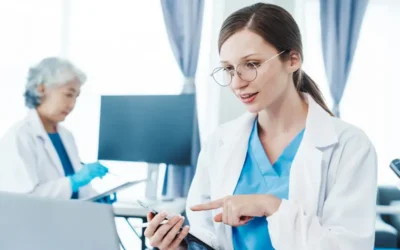Lymphedema, a common vascular condition, occurs when excess protein-rich fluids (called lymph) circulates and get accumulated within tissues in the lymphatic system causing swelling (edema). Any type of problem that blocks the drainage of lymph fluid (usually from an arm or leg) can cause lymphedema. Also called lymphatic obstruction, the condition most commonly affects the arms or legs. However, it can also occur in the chest wall, abdomen, neck and genitals. If left untreated, severe cases of lymphedema can affect the ability to move the affected limb, increase the risks of skin infections and sepsis and can lead to skin changes and breakdown. ICD-10-CM code 189.0 represents lymphedema, and can be used to indicate a diagnosis for reimbursement purposes. Vascular surgeons treating patients with this condition have to document all the diagnostic test results and any clinical findings that support the treatments provided. Vascular medical billing and coding involves reporting the condition and treatments provided using the right diagnosis and procedure codes on the medical claims.
While primary lymphedema may be caused by genetic mutations involved in the development of the lymphatic system, secondary lymphedema can be caused by other conditions like – infections, inflammatory diseases, cardiovascular conditions, radiation therapy, cancer surgery and other injuries and trauma. Factors that can increase the risk of developing lymphedema include – older age, excess weight or obesity and rheumatoid or psoriatic arthritis.
Symptoms of Lymphedema and Diagnosis
Common signs and symptoms include – restricted range of motion, recurring infections, hardening and thickening of the skin (fibrosis), swelling of part or all of the arm or leg, including fingers or toes, discomfort or aching in the affected limb, a tingling sensation (like pins and needles) in the affected limb, blisters or wart-like growths on the skin, severe fatigue and a feeling of heaviness or tightness in the arms or legs.
Diagnosis of this condition may begin with a detailed review of the symptoms as this will help analyze the possible causes of swelling, including a blood clot or an infection that does not involve the lymph nodes. For instance, for patients who have recently had cancer treatment procedures like – radiation therapy or surgery involving the lymph nodes, physicians may diagnose lymphedema based on the symptoms. On the other hand, if there isn’t any specific cause for the lymphedema, imaging tests like – MRI scan, CT scan, Lymphoscintigraphy and Doppler Ultrasound scan may be requested to have an in-depth look at the lymphatic system.
As there is no specific cure for lymphedema, treatment focuses on reducing the swelling and preventing complications related to the condition. Treatment modalities include a combination of medications, therapeutic procedures and surgical and other procedures. Antibiotics may be prescribed to reduce the symptoms immediately as and when they appear. Specialized lymphedema therapists may prescribe exercises, manual lymph drainage and compression bandages and garments. In severe cases of lymphedema, surgical procedures like lymph node transplant, new drainage paths and removal of fibrous tissue may be carried out.
In case of people with lymphedema, the affected limb is more vulnerable to skin infections since the supply of lymphocytes (which fight infection) gets reduced. Therefore, incorporating lifestyle changes and home remedies like – avoiding injuring the affected limb, and avoiding cuts, scrapes and burns (that lead to infection) can help reduce the risk of complications and subsequent infections from lymphedema.
Medical Codes for Lymphedema
While documenting diagnosis and treatment related to lymphedema, vascular specialists must report the correct medical codes. Medical billing services provided by reputable companies can help physicians report the correct codes for billing purposes. In order to ensure proper coding and timely reimbursement, it is essential to have a good awareness about the recent changes related to debridement codes.
CPT Codes
- 29581 – Application of multi-layer compression system; leg (below knee), including ankle and foot [1]
- 29584 – Application of multi-layer compression system; upper arm, forearm, hand, and fingers
- 97140 – Manual therapy techniques (e.g., mobilization/ manipulation, manual lymphatic drainage, manual traction), 1 or more regions, each 15 minutes
- 97535 – Self-care/home management training (e.g., activities of daily living (ADL) and compensatory training, meal preparation, safety procedures, and instructions in use of assistive technology devices/adaptive equipment) direct one-on-one contact, each 15 minutes
- 97597 – Debridement open wound, including topical application(s), wound assessment, user of whirlpool, when performed and instruction(s) for ongoing care, per session, total wound(s) surface area; first 20 sq. cm or less
- + 97598 – … Each additional 20 cm sq.cm of part thereof (list separately in addition to the primary procedure)
- 97602 – Removal of devitalized tissues from wounds, nonselective debridement without anesthesia, including topical applications, wound assessment and instructions for ongoing care, per session
- 11042 Debridement, subcutaneous tissue incl epidermis and dermis, first 20 sq. cm or less
- 11045 each additional 20 sq. cm
- 11043 Debridement, muscle and/or fascia incl epidermis and dermis and subQ, first 20 sq. cm or less
- 11046 each additional 20 sq. cm
11044 Debridement, bone, incl subcutaneous tissue, muscle, and/or fascia, epidermis and dermis, first 20 sq. cm or less - 11047 each additional 20 sq. cm
ICD-10 Codes
- I89 Other noninfective disorders of lymphatic vessels and lymph nodes
- I89.0 Lymphedema, not elsewhere classified
- I89.1 Lymphangitis
- I89.8 Other specified noninfective disorders of lymphatic vessels and lymph nodes
- I89.9 Noninfective disorder of lymphatic vessels and lymph nodes, unspecified
As lymphedema is a progressive condition, there is no specific cure for the same. The outlook will depend to some extent on the severity of symptoms. Incorporating healthy lifestyle habits, including a balanced diet and movement or exercise can help reduce fluid buildup and stimulate the flow of lymph.




